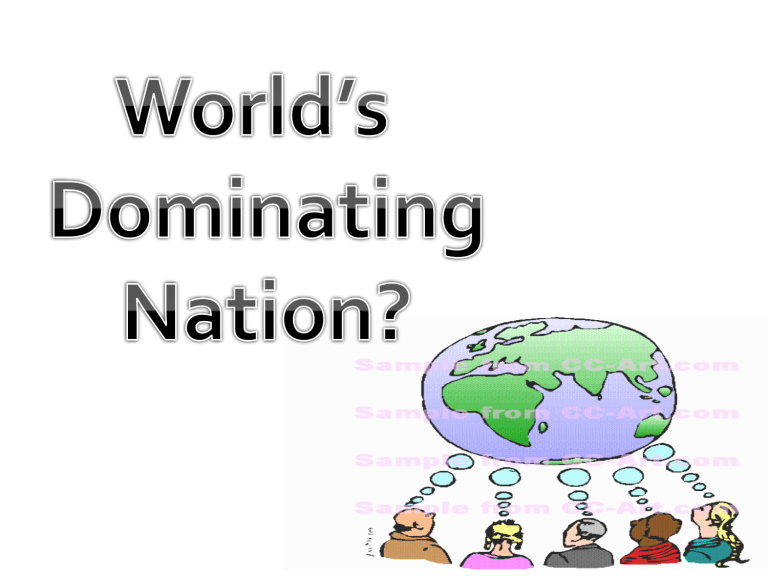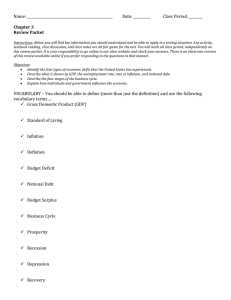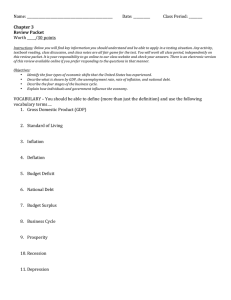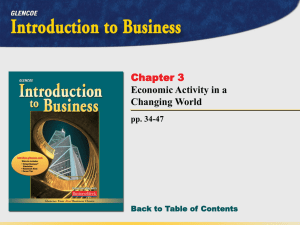
U.S. ECONOMY By Aishwarya Sankpal Aman Dubey Foram Patel Heena Patel Vivek Vijayan (Q.A+ MBA) U.S. in our mind Ups & down Myths & Facts Production Economy Consumption (Goods & servives) Trade Distribution The United State of America Federal republic consisting of 50 states and a federal district The economic history of the U.S. has its roots in EU colonization in the 16th, 17th, and 18th centuries. Marginal colonial economies grew into 13 small, independent farming economies, which joined together in 1776 to form the U.S.A. In 230 years, U.S. grew to a huge, integrated, industrialized economy making up nearly a quarter of the world economy. Major factors: large unified market, supportive political-legal system, vast areas of highly productive farmlands, vast natural resources (timber, coal, iron, and oil), technology, industries, an entrepreneurial spirit and commitment to investing in material and human capital. U.S. economy is the world's largest single national economy. Nearly $15 trillion a year in goods and services, largest in the world & most innovative and productive. The resulting economy reflects market and individual choices but is also structured and shaped by politics, policies and laws. Its GDP at purchasing power parity is also the largest of any single country in the world, approximately a 5th of global GDP. Mixed economy and has maintained a stable overall GDP growth rate, a moderate unemployment rate, and high levels of research and capital investment. As of 2010, the country remains the world's largest manufacturer, representing a fifth of the global manufacturing output. About 60% of the global currency reserves have been invested in the US dollar. The New York Stock Exchange is the world's largest stock exchange by Market capitalization, Foreign investments made in the US total almost $2.4 trillion, which is more than twice that of any other country. The U.S. is one of the top-performing economies in studies such as the Ease of doing Business, the Global Competitiveness Report, and others. The US is ranked first globally in the IT industry competitiveness index. 5 largest trading partners: Canada, china, Mexico, Japan, Germany. Abundant natural resources, a well-developed infrastructure, and high productivity. World's third-largest producer of oil and second-largest producer of natural gas. Second-largest trading nation in the world behind China. Main industries highly diversified, world-leading, high- technology innovator, second-largest industrial output in world; petroleum,steel, motor vehicles aerospace, telecommunication, chemicals, electronics, food processing, consumer goods, mining. Export Capital goods, industrial supplies and materials, consumer goods, automotive vehicles and components, food, and beverages, fuel oil and petroleum products, aircraft and components and many more. American Revolution American demand: Englishmen rights to select their own representatives to govern and tax them - Britain refused. The American economy proved resilient and able to support a sustained war (1775-1783) Alexander Hamilton (first secretary of the treasury) achieved Congressional authority to create the First Bank of the United States in 1791; the charter lasted until 1811. Evolution of US Economy Agriculture was dominant. Basically an agrarian society. In 1793, Cotton, at small-scale in the South, boomed following Eli Whitney's invention of the cotton gin. Railroads opened up remote areas, drastically cut the cost of moving freight as well as passenger travel, and stimulated new industries such as steel and telegraphy, as well as the profession of civil engineering. The railroad became the first large-scale business enterprise and the model for most large corporations. The Gilded age (1865-1900) Explosion of new discoveries and inventions : process called as the "Second Industrial Revolution“. Coal and oil was found in abundance. Large iron ore mines, steel mills opened. The "Gilded Age" of the second half of the 19th century was the epoch of tycoons and saw the greatest period of economic growth in American history. • From 1869 to 1879, the US economy grew at a rate of 6.8% for real GDP and 4.5% for real GDP per capita. • The economy repeated this period of growth in the 1880s, in which the wealth of the nation grew at an annual rate of 3.8%, while the GDP was also doubled. • Capital investment also increased tremendously during the 1880s, increasing nearly 500%. • Long-term interest rates also declined to 3 from 3.5% for the first time, reaching the same level. During the period, a series of recessions happened. Panic of 1873 : New York Stock Exchange closed for 10 days, of the country's 364 railroads, 89 went bankrupt, a total of 18,000 businesses failed between 1873 and 1875, unemployment reached 14% by 1876, during a time which became known as the Long Depression. The end of the Gilded Age coincided with the Panic of 1893, a deep depression that lasted until 1897. Progressive Era (1890-1920) Most political leaders accepted the concept of laissez- faire, a doctrine opposing government interference in the economy except to maintain law and order. Many acts were enacted such as The Interstate commerce act, Sherman antitrust act. In 1913,the income tax was instituted in the United States. Electrification in the U.S. started in industry ca. 1900 and by 1930 about 80% of power used in industry was electric. Wilson resolved the longstanding debates over tariffs and antitrust, and created the Federal Reserve, a complex business-government partnership that to this day dominates the financial world. Roaring twenties (1920-1929) The Boom was because of ‘’ I LACK PANTS’’ I- Immigration L-Laissez faire A-Assembly line C-Credit K-Knowledge P-Position of US in world A-Advertisement N-New consumer goods T-Tarrifs S-Share confidence Black Tuesday-October 1929 In late October 1929, the Wall Street Crash(Black Tuesday) and the Stock Market Crash was the most devastating in the history of the U.S., when taking into consideration the full extent and duration of its fallout. The Roaring Twenties, the decade that led up to the Crash, was a time of wealth and excess. Steel production was declining, construction was sluggish, car sales were down, and consumers were building up high debts because of easy credit. On October 24(Black Thursday), the market lost 11% of its value at the opening bell on very heavy trading. On October 28(Black Monday),more investors decided to get out of the market and the slide continued with a record loss in the Dow for the day of 38.33 points, or 13%. The next day (Black Tuesday), October 29, 1929, about sixteen million shares were traded, and the Dow lost an additional 30 points, or 12%. The market had lost over $30 billion in the space of two days which included $14 billion on October 29 alone. DROLL ♯♯ • 1930S THE GREAT DEPRESSION • ITS RECOVERY ♯♯ • 1939-1940-WWII ENERGISES ECONOMY • MIXED GROWTH ♯♯ • 1950-A STALE PERIOD • 1960-AT ITS PEAK ♯♯ • INFLATION OF 1970 • RECESSION OF 1980 THE GREAT DEPRESSION 1930S The terrible, terrible conditions which occurred in the United States and the rest of the world in the 1930's are known as the Great Depression. This depression was not only an economic catastrophe, it was social and political catastrophes as well. UNEMPLOYMENT RATE: 3.2% IN 1929 UNEMPLOYME NT FALL OF EXPORTS AND IMPORTS Exports fell but imports fell as well so that there was not much of a change in net exports The great depressionmarked by INTEREST RATES WERE HIGH 25% IN 1930 (DUE TO NO PRODUCTION – INTURN NO SELLING) Collapse of investment • Declaration of Nationwide bank holidays • Government undertook a series of emergency measures like banking and the stock market were reformed; insured private bank deposits; protected home mortgages; sought to stabilize industrial and agricultural production; • Created programmes for large public works. The parks and forests program, called the Civilian Conservation Corps, was the first socalled work relief program that provided federally funded jobs • Created a large-scale temporary jobs program during the winter of 1933–34. The Civil Works Administration employed more than four million men and women at jobs from building and repairing roads and bridges, parks, playgrounds and public buildings to creating art. WW II Energises Economy • Despite the world war II raging in world ,this period is considered as the period of growth for US • USA was not affected by the war up till the Pearl harbor attack • Jobless workers were absorbed as trainees. • Work on army camps and roads and airfields became a new focus of the WPA as private employment still lagged predepression levels. • It was the Japanese attack on Pearl Harbor in December 1941 that brought the United States into World War II sent America’s factories into full production and absorbed all available workers. • Not until 1954 that the stock market regained its pre- Depression levels. 1950s • The economy of the 1950's was A RELATIVELY STALE PERIOD OF TIME. Because it was much of an uneventful era, the economy did not experience any major problems or breakthroughs • However, the gradual growth of the U.S. during this time led the economy to its peak in the 60's. 1960s • In early 1963 inflation was stable, corporate profits were at a record high, and the stock market had rebounded, but unemployment was still too high at 5.7 percent Rising 60s During the 1960s the United States experienced its longest UNINTERRUPTED PERIOD OF ECONOMIC EXPANSION IN HISTORY. In the 1960s housing and computer industry overpowered automobiles, chemicals, and electrically powered consumer durables, which were the leading sectors in the 1950s. Big business dominated the domestic economy during this time. In 1962 the five largest industrial corporations accounted for over 12 percent of all assets in manufacturing. By 1965 General Motors, standard old of New Jersey and ford had larger incomes than all the farms in the United States. America’s overseas investment increased to $49.2 billion in 196 Stagflation 1970s • Throughout 1970's, the American economy was plagued by the unprecedented combination of soaring prices, the high unemployment, and low economic growth. • Economists dubbed the phenomena "STAGFLATION," A PERIOD OF RISING PRICES IN A STAGNANT ECONOMY. • Americans strated to lag behind. rates of inflation 1972 and • Americans foundbetween it 1980 to those of the 1980's and increasingly difficult to 1990's sustain a middle class lifestyle. The Oil Crisis Begins Gas prices suddenly doubled and fueling stations frequently ran out of gas. The oil crisis effected almost every sector of the economy . Coping with the Energy Crisis President Nixon appealed to the nation to make sacrifices in the name of conserving energy. The country was "heading toward the most acute shortages of energy since World War II.” The President asked Americans to reduce air travel, reduce work and school hours, turn down thermostats by 6 degrees, and reduce highway speed limits to conserve energy. Nixon also urged the use of coal and nuclear power rather than the limited commodity of oil. Initiation of a grassroots anti-inflation campaign, the WHIP INFLATION NOW (WIN) Recession of 80s • In January 1980 the U.S. economy entered a recession that, at the time, was the most significant since the Great Depression. • One of the causes of the early 1980s recession was the Iranian Revolution of 1979, which sparked a second large round of oil price increase. • More important were Federal Reserve Chairman Paul Volcker’s efforts to tame inflation through restrictive monetary policy. • The 1980-82 recession, which the National Bureau of Economic Research considers as two separate recessions (one lasting for the first six months of 1980, the other from July 1981 to November 1982) • The American economy experienced a modest recovery beginning in the summer of 1980 but declined again from July 1981 to November 1982 The 90s • The recession of the early 1990s lasted from July 1990 to March 1991. It was the largest recession since that of the early 1980s • From November 1982 to July 1990 the U.S. economy experienced robust growth, modest unemployment, and low inflation. The "Reagan boom" rested on shaky foundations, however, and as the 1980s progressed signs of trouble began to mount. • On October 19, 1987 stock markets around the world crashed • The early 1990s recession lasted just eight months, conditions improved slowly thereafter, with unemployment reaching almost 8% as late as June 1992 • The American housing market presented another sign of weakness, as in the second half of the 1980s a large number of savings and loan associations (private banks that specialized in home mortgages) went bankrupt. 2000s This has been a tumultuous decade for the United States During the first 10 years of the 21st Century, there was a major terrorist attack A housing meltdown A severe economic recession Significant downturn in the U.S. stock market Unemployment 2007-2009 •Financial innovation in the form of asset securitization •Government policies to increase homeownership •Global imbalances •Expansionary monetary policy •Weak regulatory. THE DOUBLE DIP DEPRESSION- 2008 After The Great Depression, US witnessed the new depression/double dip depression of 2008, characterised by; manufacturing at its lowest level in 26 years 1,20,000 jobs being shed a month the volatility on Wall Street home price plummeting Companies lay off workers Decrease in disposable income decreased consumption falling personal income massive joblessness further drop in prices companies cannot afford to produce or sell goods Industrial standstill Factors 1.push toward globalization 2.“free trade” agreements 2013 United States debt-ceiling 2012 budget, which balanced in 2063 2013 budget, which balanced in 2035 On March 21st, the house passed a FY 2014 budget that would balance the United States budget in 2023. Early July of 2013 • Short Term Debt Ceiling Increase • Medium Term Debt Ceiling Increase • Long Term Debt Ceiling Increase Economic bubble characterised by quickly increasing property values until they outperform other elements of the economy and then are followed by a decline in property value. The US meltdown 3$ 6$ 4$ 5$ MYTHS AND FACTS Even though Americans paid a record $2.7 trillion in federal taxes in 2012, as a percentage of the economy, that amounted to 16%, below the long-term average. The amount of overall debt in our country continues to reach new highs every week but it's not at its highest level in relation to GDP. As of April 2, debt held by the public was roughly $11.96 trillion, or 75% of GDP. But federal debt held by the public as a percentage of GDP was higher in the 1940s. While non-defense and defense spending are in a downward trend over the past 40 years, total federal spending as a percentage of GDP is just off its 2010 peak. Yes. Americans contribute an average of almost $50,000 to the country's GDP. That's higher than the average contribution to GDP of any other nation. Not as much as some would think. In fact no country, not even china, owns more than 2.5% of U.S. assets. Wages are growing, but barely. Since the recession, wages have grown at half the rate they did from 2000-2007. FACTS/REALITIES 1.Back in 1980, the U.S. national debt was less than 1 trillion dollars. Today, it is rapidly approaching 17 trillion dollars... 2. According to the World Bank, U.S. GDP accounted for 31.8 % of all global economic activity in 2001. That number dropped to 21.6 % in 2011. 3. During Obama's first term, the federal government accumulated more debt than it did under the first 42 U.S. president combined. 4. If you started paying off just the new debt that the U.S. has accumulated during the Obama administration at the rate of one dollar per second, it would take more than 184,000 years to pay it off. 5. Back in 1970, the total amount of debt in the United States (government debt + business debt + consumer debt, etc.) was less than 2 trillion dollars. Today it is over 56 trillion dollars. 6. There are less Americans working in manufacturing today, than there was in 1950 even though the population of the country has more than doubled since then. 4. Back in 1985, trade deficit with China was approximately 6 million dollars for the entire year. In 2012, our trade deficit with China was 315 billion dollars. That was the largest trade deficit that one nation has had with another nation in the history of the world 8. Incredibly, more than 56000 manufacturing facilities in the United States have been permanently shut down since 2001. 9.Overall, the United States has run a trade deficit of more than 8 trillion dollars with the rest of the world since 1975. 10. According to the Economic Policy Institute, the United States is losing half a million jobs to China every single year. 11. Back in 1950, more than 80 % of all men in the United States had jobs. Today, less than 65 % of all men in the United States have jobs. 12. Small business is rapidly dying in America. At this point only abot 7 % of all nonfarm workers in the United States are self-employed. That is an all-time record low. 13. According to the U.S. Census Bureau, more than 146 million americans are either "poor" or "low income". 14. Today, more than a million public school students in the United States are homeless. This is the first time that has ever happened in history. 15. When Barack Obama first entered the White House, about 32 million Americans were on food stamps. Now,more than 47 million americans are on food stamps. 16. According to the U.S. Census Bureau, 49 % of all Americans live in a home that receives direct monetary benefits from the federal government. Back in 1983, less than a third of all Americans lived in a home that received direct monetary benefits from the federal government. 17. Back in 1965, only one out of every 50 Americans was on Medicaid. Today, one out of every 6 americans is on Medicaid, and things are about to get a whole lot worse. It is being projected that Obamacare will add 16 million more americans to the Medicaid rolls. 18. As I wrote recently, it is being projected that the number of Americans on Medicare will grow from 50.7 million in 2012 to 73.2 million in 2025. http://kclibrary.lonestar.edu/decade30.html http://topics.nytimes.com/top/reference/timestopics/subje cts/g/great_depression_1930s/index.html?s=oldest&1950 http://bancroft.berkeley.edu/ROHO/projects/debt/1990sre cession.html http://elcoushistory.tripod.com/economics1950.html http://elcoushistory.tripod.com/economics1960.html http://elcoushistory.tripod.com/economics1970.html http://bancroft.berkeley.edu/ROHO/projects/debt/1980sre cession.html







